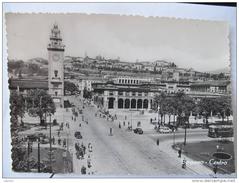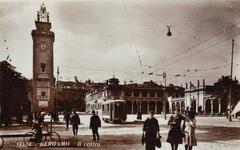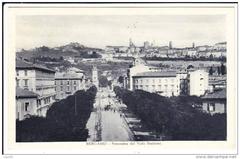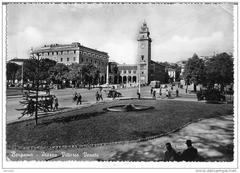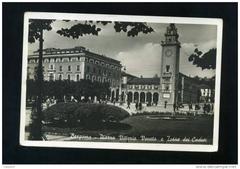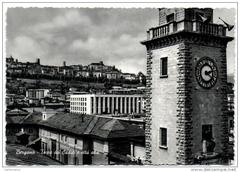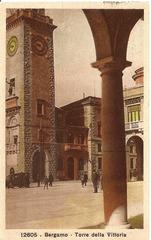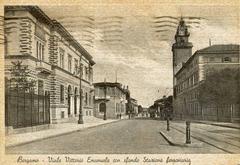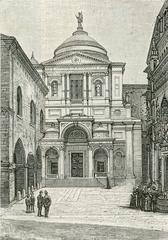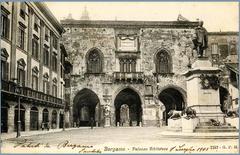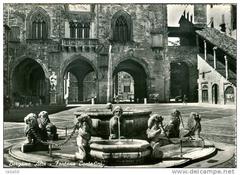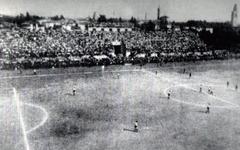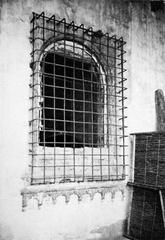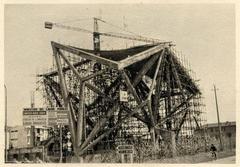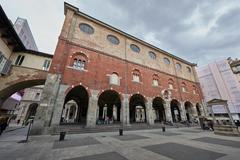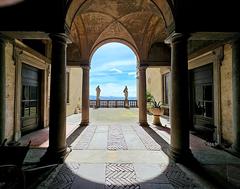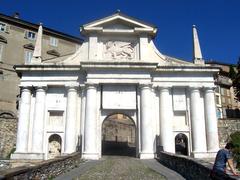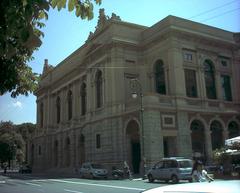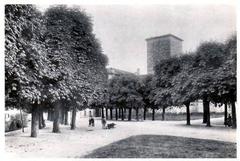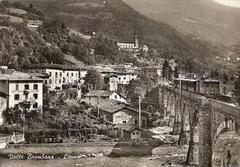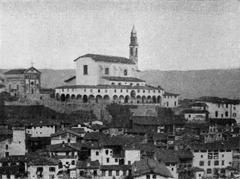
Torre dei Caduti Visiting Guide: History, Tickets, and Tips
Publication Date: 31/07/2024
Introduction to Torre dei Caduti
The Torre dei Caduti di Bergamo, or Tower of the Fallen, is a monumental tribute to the Bergamaschi soldiers who sacrificed their lives during World War I. Nestled in the heart of Bergamo’s lower city, Città Bassa, this iconic tower stands not only as a historical memorial but also as a symbol of Italy’s early 20th-century political and social transformations. Designed by the esteemed architect Marcello Piacentini, the construction of the Torre dei Caduti began in 1922 and was completed in 1924. Situated in Piazza Vittorio Veneto, the tower is part of an ambitious urban reorganization project that aimed to modernize the lower city, which gained prominence following the Napoleonic occupation (Italy Scapes).
Standing 45 meters tall, the tower’s architectural grandeur is accentuated by its Bagnatica sandstone construction, Zandobbio marble clock, and a bronze statue of Italy by Alfredo Faino. The interior is equally impressive, featuring five floors dedicated to the memory of the fallen soldiers and displaying panels on Bergamo’s development. A significant restoration in 2015 has preserved its historical integrity while making it accessible to modern visitors (Museo delle Storie di Bergamo).
This guide will delve into the rich history, architectural marvels, and essential visitor information of the Torre dei Caduti, providing a comprehensive understanding of this landmark. From ticket prices and visiting hours to nearby attractions and photography tips, this guide aims to equip you with everything you need for a meaningful visit to one of Bergamo’s most significant historical sites.
Table of Contents
- Introduction
- Historical Background
- Architectural Features
- Restoration and Modern Use
- Public and Cultural Significance
- Visitor Information
- FAQ
- Conclusion
Historical Background
Origins and Construction
The Torre dei Caduti was conceived as part of a broader urban reorganization project aimed at modernizing the lower city, which had gained economic and administrative importance following the Napoleonic occupation. The area where the tower stands, Prato di Sant’Alessandro, was historically significant as it hosted the annual Sant’Alessandro Fair, one of Lombardy’s oldest fairs dating back to the 9th century (Italy Scapes).
Designed by architect Marcello Piacentini, the tower’s construction began in 1922 and was completed in 1924. Initially intended as a decorative element, it was later repurposed as a memorial for the fallen soldiers of Bergamo, reflecting the patriotic fervor and nationalistic sentiments prevalent in post-war Italy (Museo delle Storie di Bergamo).
Inauguration and Symbolism
Inaugurated on October 27, 1924, by Benito Mussolini, the Torre dei Caduti was established to honor fallen soldiers and promote unitary nationalism. This dual-purpose monument commemorates the sacrifices of Bergamaschi soldiers and reinforces the nationalistic ideals of post-war Italy (Italy Scapes).
Architectural Features
Design and Construction
Standing 45 meters tall, the Torre dei Caduti is constructed from Bagnatica sandstone and adorned with ashlars and various ornamental elements. Notable features include the Zandobbio marble clock, framed by four allegories of the blowing winds, and a bronze statue of Italy by Alfredo Faino.
Structural Elements
The tower’s robust and monumental appearance is enhanced by its ashlar-covered façade. Ornamental elements such as a clock and various sculptural groups add to its grandeur (Italy Scapes).
Clock and Sculptures
A striking feature of Torre dei Caduti is the Zandobbio marble clock, encased in a square frame adorned with allegories of the blowing winds, symbolizing the passage of time. Below the clock, a niche houses a bronze statue of Italy, holding Victory in her right hand and a sword in her left. This statue, created in 1923 by sculptor Alfredo Faino, adds a commemorative touch (Museo delle Storie di Bergamo).
Interior Layout
The tower’s interior spans six floors, each dedicated to different aspects of Bergamo’s history and the tower’s significance. The first floor serves as a memorial hall, honoring Bergamo’s fallen World War I soldiers, with 797 names engraved in gold on black marble slabs. This floor also features a walnut crucifix by the Zonca brothers, based on an old Fantoni model, added in 1925 (Museo delle Storie di Bergamo).
Commemorative Elements
The lower floors of the tower display the names of fallen soldiers, while the upper floors feature panels illustrating the city’s development. The second floor focuses on the tower’s construction and Bergamo’s life during the Great War, while the fourth floor highlights daily life around the tower, emphasizing leisure and recreation (Museo delle Storie di Bergamo).
Panoramic Terrace
The tower’s panoramic terrace offers a 360-degree view of Bergamo and its surroundings. Visitors can enjoy views of the upper city, Piacentini’s center, the Sentierone, and the boulevard connecting the upper city to the railway station, as well as Bergamo expanding towards Milan (Museo delle Storie di Bergamo).
Decorative Features
Decorative elements enhance the tower’s visual appeal, including the statue of Italy, which rests on a large dedicatory plaque above a polychrome marble window. This window is framed by a balustraded balcony resting on allegories of weapons. In the lunette of the large window, two cherubs hold the Bergamo coat of arms, while bas-reliefs of Admiral Paolo Thaon di Revel and General Armando Diaz dominate the scene. Below the window, a plaque displays the victory bulletin of General Diaz (Italy Scapes).
Restoration and Modern Use
After decades of exposure, the Torre dei Caduti underwent restoration and reopened to the public on May 24, 2015. The restoration preserved the tower’s historical and architectural integrity while making it accessible to modern visitors. Today, it is part of the Museo delle Storie di Bergamo, offering an engaging historical narrative (Museo delle Storie di Bergamo).
Public and Cultural Significance
Located at the beginning of the Sentierone, the Torre dei Caduti is not just an architectural marvel but also a symbol of Bergamo’s modern history. Built in the wake of patriotic rhetoric following World War I, it honors the fallen soldiers of Bergamo and aims to enhance unitary nationalism. This sentiment was expressed in Benito Mussolini’s inauguration speech on October 27, 1924 (Wikipedia).
Visitor Information
Visiting Hours and Tickets
The Torre dei Caduti is open to visitors from March 1 to November 4. Specific visiting hours are as follows: Tuesday to Sunday from 10:00 AM to 6:00 PM. The tower is closed on Mondays. Ticket prices are as follows: €5 for adults, €3 for students and seniors, and free for children under 12. Discounts are available for groups and families (Visit Bergamo).
Best Time to Visit
The best time to visit the Torre dei Caduti is during the spring and autumn months when the weather is mild and the skies are clear, offering the best panoramic views from the terrace. Visiting during these times also means avoiding the peak summer tourist season, which can be crowded and hot.
Accessibility
The tower is easily accessible from various parts of Bergamo. It is located about 750 meters from the Bergamo railway station, and the closest bus stop is on Viale Roma 4, about 80 meters away, served by bus Line 1 (Italy Scapes). However, visitors should be prepared to climb several flights of stairs to reach the top. Unfortunately, there is no elevator available, so the tower may not be suitable for all visitors (Italia Like a Local).
Guided Tours
For a more enriching experience, consider booking a guided tour. These tours are available in English and provide detailed insights into the history and significance of the Torre dei Caduti, as well as the surrounding area. Guided tours can be booked in advance through the official website (Museo delle Storie di Bergamo).
Nearby Attractions
The Torre dei Caduti is located in the heart of Lower Bergamo, near the Porta Nuova porticoes. After visiting the tower, you can explore other nearby attractions such as the Piazza Matteotti, which features beautiful buildings like the Teatro Gaetano Donizetti and the Chiostro di Santa Maria. The square also has monuments dedicated to Vittorio Emanuele II and the Partigiano (The Crazy Tourist).
Photography Tips
The terrace of the Torre dei Caduti offers a 360-degree panoramic view of Bergamo, making it an excellent spot for photography. On clear days, you can see as far as Milan and the Alps. To capture the best photos, visit during the early morning or late afternoon when the lighting is optimal. A wide-angle lens can help capture the expansive views, and a tripod can be useful for steady shots (Italia Like a Local).
Safety and Etiquette
While climbing the tower, be mindful of your surroundings and watch your step, especially on the narrow staircases. It is important to respect the historical significance of the site by not touching or damaging any exhibits. Keep noise levels to a minimum to maintain a peaceful environment for all visitors. Additionally, be considerate of other tourists when taking photos, ensuring you do not block pathways or views.
Refreshments and Facilities
There are no refreshment facilities within the Torre dei Caduti itself, so it is advisable to bring a bottle of water, especially during the warmer months. However, the surrounding area of Lower Bergamo offers numerous cafes and restaurants where you can enjoy a meal or a drink after your visit. Public restrooms are also available in the vicinity, but it is a good idea to use facilities before starting your climb up the tower.
Souvenirs and Memorabilia
For those looking to take home a piece of their visit, there are several souvenir shops in the area around the Torre dei Caduti. These shops offer a variety of items, including postcards, books, and local crafts that commemorate your visit to Bergamo. Additionally, the Museo delle Storie di Bergamo often has a small gift shop with educational materials and memorabilia related to the tower and its history (Museo delle Storie di Bergamo).
Weather Considerations
Bergamo experiences a temperate climate with distinct seasons. Summer months can be hot, with temperatures often exceeding 30°C (86°F), while winters can be cold, with temperatures occasionally dropping below freezing. Spring and autumn offer the most comfortable weather for visiting the Torre dei Caduti. It is advisable to check the weather forecast before your visit and dress accordingly. On rainy days, the climb can be slippery, so extra caution is needed (Wanderlog).
Cultural Insights
Understanding the cultural and historical context of the Torre dei Caduti can enhance your visit. The tower was built in 1923 by architect Alfredo Faino to commemorate the fallen soldiers of World War I. It stands as a symbol of modern Bergamo and the city’s resilience. The exhibitions inside the tower provide a fascinating look into the development of the city center and the lives of its inhabitants during the early 20th century (Visit Bergamo).
FAQ
What are the visiting hours for Torre dei Caduti? The Torre dei Caduti is open from March 1 to November 4, Tuesday to Sunday from 10:00 AM to 6:00 PM. The tower is closed on Mondays.
How much are tickets for Torre dei Caduti? Ticket prices are €5 for adults, €3 for students and seniors, and free for children under 12. Discounts are available for groups and families.
Is Torre dei Caduti accessible by public transport? Yes, the tower is about 750 meters from the Bergamo railway station, and the closest bus stop is on Viale Roma 4, about 80 meters away, served by bus Line 1.
Are guided tours available? Yes, guided tours are available upon request, providing deeper insights into the tower’s history and significance.
What can you see from the panoramic terrace? The panoramic terrace offers 360-degree views of Bergamo, including the upper city, Piacentini’s center, the Sentierone, and the boulevard towards Milan.
Conclusion
In summary, the Torre dei Caduti is a multifaceted monument that combines architectural beauty with historical significance. Its design, structural elements, and commemorative features make it a must-visit landmark for anyone interested in the rich history and culture of Bergamo. Plan your visit today to explore this iconic tower and immerse yourself in Bergamo’s heritage.
For more travel guides and tips, download our mobile app Audiala, check out our other related posts, and follow us on social media.



